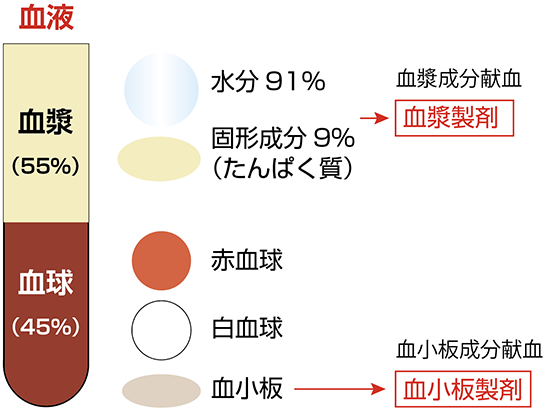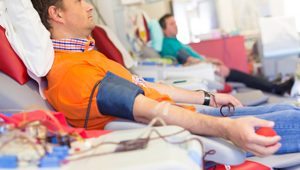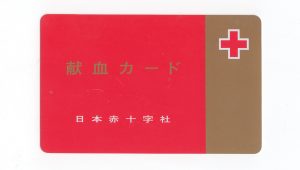Do you have experience with component blood donation?
Many of you may have donated regular blood (officially called whole blood donation), but surprisingly few of you may have donated component blood.
I have donated whole blood for many years, but I have only donated component blood once, a long time ago, at a blood donation room in the city (component blood donation requires a special large machine.
(Component blood donation requires a special large machine, which is usually not available on blood donation buses. ) I ‘ve heard that some buses can do it.
Even now, I hear the call from the JRC in various places, “Please donate component blood. This article summarizes the differences and risks between component blood donation and whole blood donation.
Although I myself have had actual experience with both types of blood donation, there were many things that I vaguely remembered, and I think I learned a lot from this research.
If you are not familiar with component blood donation, I hope this will be of interest to you and encourage you to consider which is better for you.

Let’s start with what is component blood donation? (*^▽^*) I will start with “What is component blood donation? (*^▽^*)
What is Component Blood Donation?
Component blood donation is a process in which only certain components of blood are extracted and donated.
In contrast, regular blood donation involves donating all of the blood, as well as those components. There is no difference in donating blood in either case, but there is a difference between partial and full donation. (In component donation, the blood passes through a machine and is returned to the body.)
There are two types of component blood donation, platelet component blood andplasma component blood, depending on the component to be taken out. I believe I was a platelet donor at the time. (I was told that red blood cells are slow to recover, so they are not taken out and returned.)
By the way, regular blood donation is called whole blood donation (total blood donation).
What is the difference between component blood donation and regular blood donation (whole blood donation)?
Difference in the burden on the body
Regular blood donation takes 400mL or 200mL of blood, which is still a certain amount of strain on the body, even for healthy people. Sometimes people feel ill after donating blood.
Compared to this, component blood donation involves removing the blood, separating and extracting the necessary components from it in a centrifuge, and then returning it to the body. Compared to whole blood donation, component blood donation places less burden on the circulatory system and is gentler on the body.
The burden on the day of donation is also less, but the number of times you can donate blood per year is also very different. (I will write more about this in a later section.)
Differences in Usage
Generally speaking, the term “blood transfusion” conjures up an image of putting in the whole blood. It is true that there are many cases where such a need exists, such as in surgery, but as medical science has advanced, there are more and more cases where only what is necessary for the patient is required, without the need to put in the entire blood supply.
These are called “blood products,” and include“red blood cell products” and “platelet products ” made from blood cell components, and “plasma products” made from plasma components, depending on the patient’s condition.

Component blood donations are essential for the production of platelet and plasma products, among others.
They can make many blood products from the component blood received from one person. Therefore, compared to whole blood donations, there is no need to collect a large number of people.
This also means that the risk of viral infections in the blood is greatly reduced.
Differences in the time it takes to collect
The biggest disadvantage of component blood donation is the time it takes. While a regular blood donation takes about 15 minutes to complete, component blood donation can take up to an hour. (The time is for the actual drawing of the blood, and does not include preparation time such as checking by a doctor.)
Let me summarize once here.
| Whole blood donation | Component blood donation | |
|---|---|---|
| Blood donor’s physical burden | Somewhat | Less |
| Time required for blood donation | About 10 to 15 minutes | About 40 minutes to 1 hour |
Come to think of it, when I donated component blood, it seemed to take quite a long time, I forget if it was an hour or not, but I thought it was long.
But even if it took a little longer, I was glad to know that it was less stressful on my body.
Difference in the number of times you can donate blood in a year
The number of times you can donate blood in a year is much different than that of whole blood donation because of the lower burden.
The following is an excerpt from the Japanese Red Cross website.
| Component blood donation | Component blood donation | Whole blood donation | Whole blood donation | |
|---|---|---|---|---|
| Type of donation | Platelet donation | Plasma component donation | 400mL | 200mL |
| Volume of blood collected at one time | 600mL or less (within 12% of circulating blood volume) | 600mL or less (within 12% of circulating blood volume) | 400mL | 200mL |
| Age | Male 18-69 years old, Female 18-54 years old | 18-69 years old | Male 17-69 years old, Female 18-69 years old | 16-69 years old |
| Weight | Male 45kg or more, Female 40kg or more | Male 45 kg or more, female 40 kg or more | 50 kg or more for both sexes | Male 45 kg or more, female 40 kg or more |
| Number of blood donations per year | One platelet component blood donation is converted into two platelet component blood donations, for a total of 24 platelet and plasma component blood donations or less. | One platelet donation is equivalent to two platelet donations, for a total of 24 or less when combined with plasma component blood donation. | Men: up to 3 times Within 2 times for women | Within 6 times for males Women: 4 times or less |
| Total annual blood collection | - | -Total annual volume of blood donated | Total annual volume of blood donated (400mL and 200mL combined): within 1,200mL for males and 800mL for females. | Total annual volume of blood collected – – 400mL and 200mL blood donation combined within 1,200mL for men and 800mL for women |
Reference: From the Japanese Red Cross Society’s blood donation standards by donation method.
So platelet component and plasma component blood donations can be made a considerable number of times.
- Time-consuming.
- You have to go to a blood donation room that is set up.
However, if I can help people so much while putting little burden on my body, I would like to do it from time to time.
This also means that the risk of viral infections in the bloodstream is greatly reduced.
What are the risks of component blood donation?
Blood donation is a medical procedure. Of course, it is performed safely and under adequate supervision, but it is not completely risk-free.
The following are two of the main risks associated with component blood donation.
- One of the risks of blood donation in general is “vasovagal reaction,” an imbalance of the autonomic nervous system. This can cause a drop in blood pressure and blood flow to the brain, which can lead to dizziness, lightheadedness, and moodiness. This is especially common among first-time blood donors and women, and the rate is higher for component blood donors than for whole blood donors.
- In component blood donation, citric acid is added to the blood to prevent it from clotting when it leaves the body, and in rare cases, this can cause mild numbness of the lips and fingers. When such a reaction occurs, taking calcium is said to improve the situation.
These risks should be explained to you when you donate blood, but you should ask your doctor or nurse just to be sure.
Conclusion
The excellent aspect of component blood donation is that it is relatively easy on the body.
Although it is suitable for many people, as mentioned above, there are some restrictions such as age and weight. While never overdoing it, we hope that you will cooperate in component or whole blood donation if possible.
Certainly, blood donation is not without risk. However, the joy of being able to help so many people is irreplaceable.
I have donated blood quite a few times over the years, and I will continue to do so proactively. (*^o^*)
See also this related article.





Comments